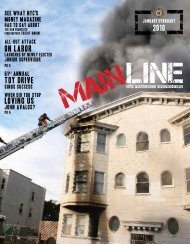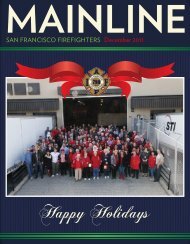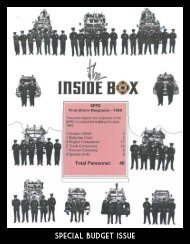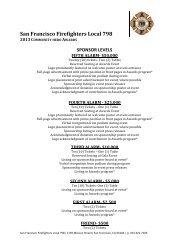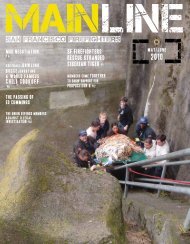Mainline - San Francisco Firefighters Local 798
Mainline - San Francisco Firefighters Local 798
Mainline - San Francisco Firefighters Local 798
You also want an ePaper? Increase the reach of your titles
YUMPU automatically turns print PDFs into web optimized ePapers that Google loves.
you know someone who has had one<br />
of these infections and if not, you most<br />
likely will soon.<br />
In 2007, the Tucson Fire Department and<br />
the University of Arizona College Of Public<br />
Health engaged in a study to investigate<br />
Methicillin Resistant Staphylococcus<br />
aureus (MRSA) in the firefighter and<br />
EMS provider environment. The results<br />
were shocking in that they found it in a<br />
nuber of places —where you sit, sleep,<br />
live a n d e at. T h i s st u d y d e term<br />
i n e d the occurrence and frequency<br />
of MRSA and other bacterial indicators<br />
on environmental surfaces in<br />
fire stations, training sites, and offices of<br />
Emergency Medical Responders.<br />
Handled sponges were used for collection<br />
of targeted bacteria from commonly<br />
contacted environmental surfaces at<br />
Emergency Medical Response facilities.<br />
Biochemical tests confirmed isolates as<br />
S aureus, and MRSA was confirmed by<br />
growth on selective and differential media.<br />
An initial set of 500 samples were collected<br />
at 9 fire-related facilities to identify<br />
areas of increased exposure. Subsequent<br />
studies targeted sites (n=160) for repeat<br />
sampling that were MRSA positive. S aureus<br />
was isolated from 10.6% (17/160) of<br />
the sampled sites.<br />
The couch and the classroom desks were<br />
the most contaminated at 20% (4/20 and<br />
2/10, respectively). Of the S aureus isolated,<br />
64.7% (11/17) were confirmed as<br />
MRSA. <strong>Firefighters</strong> have a high potential<br />
for exposure to MRSA, not only through<br />
patient and hospital contacts but also in<br />
the fire station environment. MRSA “was<br />
isolated with the highest frequency on<br />
the couches and the class desks,” wrote<br />
J.D. Sexton and colleagues, University of<br />
Arizona.<br />
The researchers concluded: “Although<br />
the true health significance of these exposures<br />
is unknown, improved infection<br />
control practices, such as routine hand<br />
washing and surface disinfection, are<br />
warranted to reduce MRSA exposures.”<br />
Basic infection control procedures<br />
Remember the fact that hazardous<br />
exposures don’t just occur outside the<br />
firehouse.<br />
<strong>Firefighters</strong> spend long periods of time<br />
together, in close contact (for a workplace),<br />
in facilities that are occupied 24<br />
hours/day, 365 days/year. Under these<br />
circumstances, cleanliness and personal<br />
hygiene are not optional. Hand washing<br />
is still the number one way to decrease<br />
risk. Use soap and warm water for a minimum<br />
of 15 seconds or an alcohol based hand<br />
cleaner when water is not available.<br />
Change your clothes if exposed to an<br />
infectious environment and wash them<br />
at the station or have them professionally<br />
laundered – DO NOT take them home.<br />
At your firehouse, we need to designate<br />
clean and dirty areas. Typically where<br />
the apparatus bay meets the living area<br />
is a great place to start. Alcohol based<br />
hand cleaner dispensers placed at each<br />
entry point in the firehouse, should be<br />
used before entry. How about morning<br />
cleanups?<br />
Don’t just clean the bathrooms because<br />
we need something to do; remember<br />
that it can actually help keep someone<br />
from getting sick or potentially contracting<br />
an illness. The same thing goes for<br />
kitchens, floors, furniture, etc., and make<br />
sure the cleaners you use in the house<br />
meet the EPA H list for MRSA. Our<br />
Formulation 64-RP (the red stuff you<br />
dump into toilets instead of cleaning<br />
them) is effective against MRSA with a<br />
10 minute contact time. This means that<br />
it is left on the surface you are disinfecting<br />
for a minimum of 10 minutes before<br />
it is wiped dry. Given the constant use<br />
and abuse to which firehouses are<br />
subjected, it’s also a good idea to<br />
select and maintain furnishings that can<br />
be easily cleaned (not necessarily an old<br />
fuzzy sofa someone brought in from their<br />
home). In the Tucson study, a cloth couch<br />
was cultured and produced 664,000<br />
MRSA. After switching to furniture<br />
covering that was cleanable with<br />
disinfectants they cultured zero (like<br />
none).<br />
The chain of infection is pretty sneaky. It<br />
only takes 10 of these little microscopic<br />
MRSA bugs to make you sick. So you lean<br />
against the patient’s bed, the bugs cling<br />
to your pants, your jump bag on the floor<br />
gathers more of them. You touch the<br />
patient with gloved hands, picking up<br />
more of the little guys and your gloves<br />
touch your jump bag. Now put the jump<br />
bag over your shoulder and walk back to<br />
the rig. Get on the rig, go back to the<br />
firehouse and have a seat on the couch.<br />
Sounds like thirty times a day for some of<br />
the busier companies. Hopefully you get<br />
the point.<br />
Am I needlessly ringing the alarm?<br />
Based on recent events in my firehouse,<br />
I think not. Time will tell. Though<br />
many believe that MRSA is the next big<br />
epidemic, we’re not helpless against it.<br />
Be creative with solutions, and break the<br />
chain of infection. There is no substitute<br />
for doing the simple things we all learned<br />
early in our careers: If you are sick, use<br />
your sick time, go see your doctor and<br />
don’t come back to work until you are<br />
well again. Remember that you’re not<br />
just protecting yourself, but your fellow<br />
firefighters and the family you go home<br />
to. Be safe, be well.<br />
www.sffdlocal<strong>798</strong>.org Main Line 29




